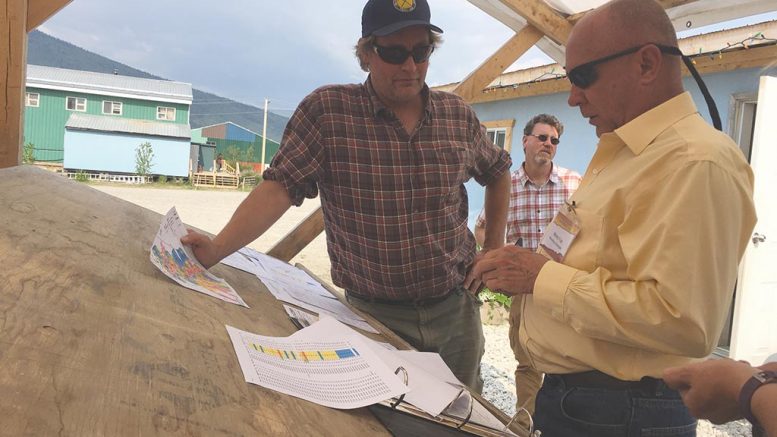VANCOUVER — The rush is on for Klondike Gold (TSXV: KG; US-OTC: KDKGF) in the Yukon’s 20 million oz. Klondike placer goldfields. The junior explorer has mobilized a second drill rig onto its 527 sq. km Klondike gold property, outside Dawson City, with the target of drilling 40 holes in less than 30 days.
The 4,000-metre program follows the company’s Aug. 16 press release, which details an open-ended and largely untested 4 km gold-in-soil anomaly across the property’s Lone Star target area.
The higher-grade core of the anomaly, which ranges from 0.075 gram per tonne to 2.9 gram gold, coincides with the drilled Lone Star target and extends 700 metres northwest and 1 km southeast towards the O’Neil and Pioneer target areas.
“The soil survey has given us a huge number of targets right off the bat, so we decided get another drill,” Peter Tallman, Klondike Gold’s president and CEO, tells The Northern Miner during a phone interview. “We’re hoping to test the entire 4 km length of the anomaly and prove that mineralization is continuous.”
Klondike Gold has drilled 4,000 metres this year into Lone Star — a structurally controlled gold system discovered by the company in 2016. Drilling has defined mineralization over an 800-metre strike length to 100 metres of vertical depth, with intercepts at surface of 40.9 metres of 2.4 grams gold and 30.7 metres of 1.6 grams gold.
In July, The Northern Miner visited Tallman at the company’s core shack — a short drive along the quartz-gravel roads of Dawson City — to discuss the results and investigate the drill core.
At the shack, Lone Star’s drill core was marked with flagging tape to highlight the high-grade gold hits. The rocks within the intervals are mostly schists speckled with finely disseminated, gold-bearing pyrite grains, and occasionally cut by narrow quartz veins glinting with visible gold.
The schists sit above a thick interval of fault gouge, which Tallman has coined the Bonanza Fault. He says the fault, which separates an underlying felsic unit from the mineralized schists, is a splay off a regional-trending thrust fault that may have injected gold into the Klondike.
Parts of the thrust were later incised by three of the most productive placer gold creeks in the region — Eldorado, Bonanza and Victoria Gulch — which accounted for 8 million historical placer oz. gold production.
“This fault system and plumbing network can explain the source of almost half of the placer gold found in the Klondike,” Tallman said. “The region has been explored and mined for 120 years, and yet no one has figured out the geology until now.”
How the gold occurs in the rocks varies, he continued. At the project’s Nugget Zone, which was the focus of previous drilling, gold is found in a complex vein array in competent mafic rocks. Drilling at Lone Star this year has unveiled a whole new target.
“We started to notice a stratigraphic control to mineralization at Lone Star,” he said. “The gold was pumped into this permeable schist unit and reacted with the pyrite. That has created a broad zone of gold-bearing rock that’s easier to trace in drilling.”
The geology and mineralization style at Lone Star is also seen at the O’Neil and Pioneer targets, where recent drilling has hit visible gold in quartz veins. Assay results are still pending.
“We now have at least 2 km of known mineralization at surface, and I think it keeps going,” Tallman said. “We have geophysics and soil geochemistry that suggest mineralization continues considerably farther, and we have a geological model that explains the hits as well as the misses.”
And the geological model continues to evolve. Grab samples from outcropping quartz veins at the O’Neil and the new Victoria Gulch area have returned unusually high antimony-bismuth-tellurium geochemistry — a signature that is more associated with a Cretaceous-aged, intrusion-related mineralization similar to the 37 million oz. Donlin Creek gold deposit in Alaska than the older, Jurassic-aged gold-rich fluids that endowed the Klondike.
“What we’ve picked up in prospecting this year is a set of quartz veins with a different structural trend and chemical signature than what we’re seeing at Lone Star,” Tallman said. “Where these two styles of mineralization overprint, we see an uptick in gold grades, so we’re aiming to test that theory and see what we uncover.”
Klondike Gold is fully funded to complete its next round of drilling. The company recently closed the first tranche of a $5-million private placement, issuing flow-through and non-flow-through units for 34¢ to 29¢. Both types of units come with a half warrant, exercisable within two years at 45¢ (flow-through) and 40¢ (non flow-through) per share. The proceeds would go towards next year’s exploration.
Financier Frank Giustra owns 22% of Klondike Gold.


Be the first to comment on "Klondike Gold to ramp up drilling in Yukon"